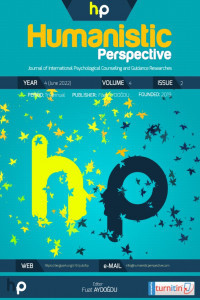Bir İl Merkezinde Yaşayan Bireylerin Ruh Sağlığı Okuryazarlığının İncelenmesi
ruh sağlığı, ruh sağlığı okuryazarlığı, sağlık okuryazarlığı
Investigation of Mental Health Literacy of Individuals Living In A City Center
___
- Baştürk, S., & Taştepe, M. (2013). Evren ve örneklem. Bilimsel Araştırma Yöntemleri. Vize Yayıncılık.
- Bjørnsen, H. N., Eilertsen, M., Ringdal, R., Espnes, G. A., & Moksnes, U. K. (2017). Positive mental health literacy: development and validation of a measure among Norwegian adolescents. BMC Public Health, 17(1), 717-727. https://doi.org/10.1186/s12889-017-4733-6
- Bowers, L., Banda, T., & Nijman, H. (2010). Suicide inside: a systematic review of inpatient suicides. The Journal of Nervous and Mental Disease, 198(5), 315–328. https://doi.org/10.1097/NMD.0b013e3181da47e2
- Corrigan, P. W., Powell, K. J., & Al-Khouja, M. A. (2015). Examining the Impact of Public Service Announcements on Help Seeking and Stigma: Results of a Randomized Controlled Trial. The Journal of Nervous and Mental Disease, 203(11), 836–842. https://doi.org/10.1097/NMD.0000000000000376
- Evans-Lacko, S., Malcolm, E., West, K., Rose, D., London, J., Rüsch, N., Little, K., Henderson, C., & Thornicroft, G. (2013). Influence of Time to Change's social marketing interventions on stigma in England 2009-2011. The British Journal of Psychiatry Supplement, 202(S55), 77–88. https://doi.org/10.1192/bjp.bp.113.126672
- Göktaş, S., Işıklı, B., Önsüz, M., Yenilmez, Ç., Metintaş, S. (2019). Ruh Sağlığı Okuryazarlığı Ölçeği’nin (Rsoy Ölçeği) Türkçe Geçerlilik ve Güvenilirliğinin Değerlendirilmesi. Konuralp Medical Journal, 11(3), 424-431. https://doi.org/10.18521/ktd.453411
- Jorm, A. F. (2012). Mental health literacy: empowering the community to take action for better mental health. The American Psychologist, 67(3), 231–243. https://doi.org/10.1037/a0025957
- Jorm, A. F., Korten, A. E., Jacomb, P. A., Christensen, H., Rodgers, B., & Pollitt, P. (1997). Mental health literacy: A survey of the publics ability to recognise mental disorders and their beleifs about the effectiveness of treatment. Medical Journal of Australia, 166(4), 182–186.
- Jung, H., Von Sternberg, K., & Davis, K. (2016). Expanding a measure of mental health literacy: Development and validation of a multicomponent mental health literacy measure. Psychiatry Research, 243, 278–286. https://doi.org/10.1016/j.psychres.2016.06.034
- Kaneko, Y., & Motohashi, Y. (2007). Male gender and low education with poor mental health literacy: a population-based study. Journal of Epidemiology, 17(4), 114–119. https://doi.org/10.2188/jea.17.114.
- Karasar, N. (2017). Bilimsel Araştırma Yöntemi. Nobel Yayınevi.
- Kılıç, C. (1998). Erişkinlerle ilgili sonuçlar. Türkiye Ruh Sağlığı Profili: ana rapor (Erol N, Kılıç C, Ulusoy M, Keçeci M, Şimşek Z, Ed.). Sağlık Bakanlığı Yayınları.
- Kutcher, S., Wei, Y., & Coniglio, C. (2016). Mental Health Literacy: Past, Present, and Future. Canadian Journal of Psychiatry. Revue Canadienne de Psychiatrie, 61(3), 154–158. https://doi.org/10.1177/0706743715616609.
- Lee, H. Y., Hwang, J., Ball, J. G., Lee, J., & Albright, D. L. (2020b). Is health literacy associated with mental health literacy? Findings from Mental Health Literacy Scale. Perspectives in Psychiatric Care, 56(2), 393–400. https://doi.org/10.1111/ppc.12447
- Lee, H. Y., Hwang, J., Ball, J. G., Lee, J., Yu, Y., & Albright, D. L. (2020a). Mental Health Literacy Affects Mental Health Attitude: Is There a Gender Difference?. American Journal of Health Behavior, 44(3), 282–291. https://doi.org/10.5993/AJHB.44.3.1
- Li, H. (2012). Mental health literacy, stigma, and early intervention. Elsevier Science BV.
- Mehrotra, K., Nautiyal, S., & Raguram, A. (2018). Mental health literacy in family caregivers: A comparative analysis. Asian Journal of Psychiatry, 31, 58–62. https://doi.org/10.1016/j.ajp.2018.01.021
- Miles, R., Rabin, L., Krishnan, A., Grandoit, E., & Kloskowski, K. (2020). Mental health literacy in a diverse sample of undergraduate students: demographic, psychological, and academic correlates. BMC Public Health, 20(1), 1699-1712. https://doi.org/10.1186/s12889-020-09696-0
- Naidu, A. (2008). Health literacy. Whitireia Nursing Journal, 15, 39–46.
- Özel, Y. (2018). Ruh Sağlığı Okuryazarlığı. Akademik Sosyal Araştırmalar Dergisi, 77, 380-387.
- Öztaş, B., & Aydoğan, A. (2021). Sağlık profesyonellerinin ruh sağlığı okuryazarlık düzeylerinin belirlenmesi. Psikiyatri Hemşireliği Dergisi. https://doi.org/10.14744/phd.2021.43265
- Rababah, J. A., Al-Hammouri, M. M., Drew, B. L., & Aldalaykeh, M. (2019). Health literacy: exploring disparities among college students. BMC Public Health, 19(1), 1401-1414. https://doi.org/10.1186/s12889-019-7781-2
- Reavley, N.J., Jorm, A.F. (2011). National survey of mental health literacy and stigma. Canberra: Department of Health and Ageing.
- Saito, A. S., & Creedy, D. K. (2021). Determining mental health literacy of undergraduate nursing students to inform learning and teaching strategies. International Journal of Mental Health Nursing, 30(5), 1117–1126. https://doi.org/10.1111/inm.12862
- Sezgin, D. (2013). Sağlık okuryazarlığını anlamak. Galatasaray Üniversitesi İletişim Dergisi, 72-92.
- Sungur, M. Z. (2000). Şizofreni: Mitler ve gerçekler. Klinik Psikiyatri Dergisi, 3(1), 5-12.
- Türkiye İstataistik Kurumu. (2021, Şubat). Kırşehir Nüfusu 2020. TÜİK Kurumsal (tuik.gov.tr)
- Vimalanathan, A., & Furnham, A. (2019). Comparing physical and mental health literacy. Journal of Mental Health (Abingdon, England), 28(3), 243–248. https://doi.org/10.1080/09638237.2018.1466050
- Wang, J., & Lai, D. (2008). The relationship between mental health literacy, personal contacts and personal stigma against depression. Journal of Affective Disorders, 110(1-2), 191–196.
- Yap, M. B., Reavley, N. J., & Jorm, A. F. (2012). Associations between awareness of beyondblue and mental health literacy in Australian youth: Results from a national survey. The Australian and New Zealand journal of Psychiatry, 46(6), 541–552. https://doi.org/10.1177/0004867411435288
- ISSN: 2687-4229
- Yayın Aralığı: Yılda 3 Sayı
- Başlangıç: 2019
- Yayıncı: Fuat AYDOĞDU
Ebeveynlerin Aile Hayatı ve Çocuk Yetiştirme Tutumları ile Ergenlerin İnternet Bağımlılığı
Sabahat COŞKUN, Hülya SARAY KILIÇ, Gamze SARIKOÇ
Ergenlerde Yaratıcılık ve Duygu Düzenlemeyi Yordamada Algılanan Anne Baba Tutumlarının Rolü
Özge ERDURAN TEKİN, Ayşe Esra ASLAN
Çocuklar İçin Zorbalığa Yönelik Tutum Ölçeği’nin Geçerlilik ve Güvenirlik Çalışması
Abdulkadir M.m. FAKİRULLAHOĞLU, Armağan KÖSEOĞLU
Bir İl Merkezinde Yaşayan Bireylerin Ruh Sağlığı Okuryazarlığının İncelenmesi
Dijital Teknolojinin Yansımaları: Ebeveyn Teknoferansı ve Sosyotelizmi
Pozitif Psikoloji Akımının Zihinsel Yetersizliği Olan Çocuğa Sahip Anneler Örnekleminde İncelenmesi
Koronavirüs Anksiyetesiyle İntihar Olasılığı Arasındaki İlişkide Öz Yeterliliğin Aracı Rolü
Musa YILDIRIM, Ümit BAYIN, Özge AKINCI GÖKDAL, Mustafa KOÇ
Şema Terapi Temelli Psiko-eğitim Programının Öğretmenlerin Depresyon ve Mutluluk Düzeyine Etkisi
